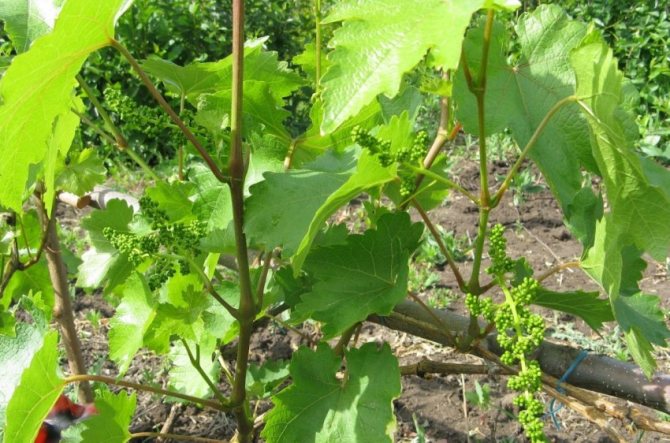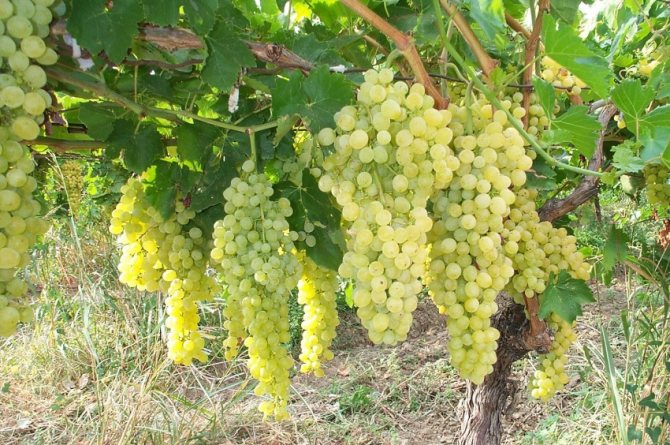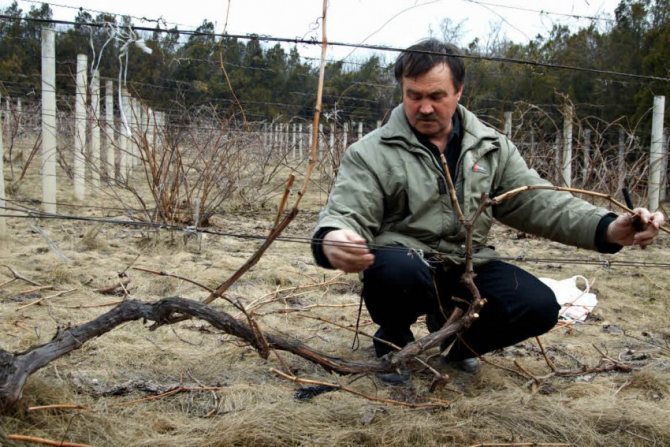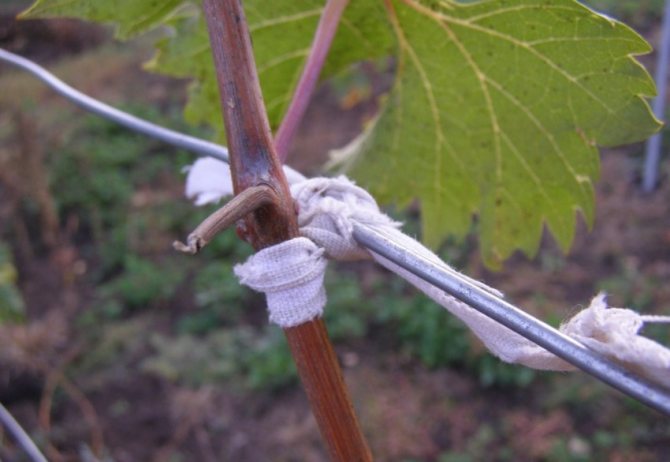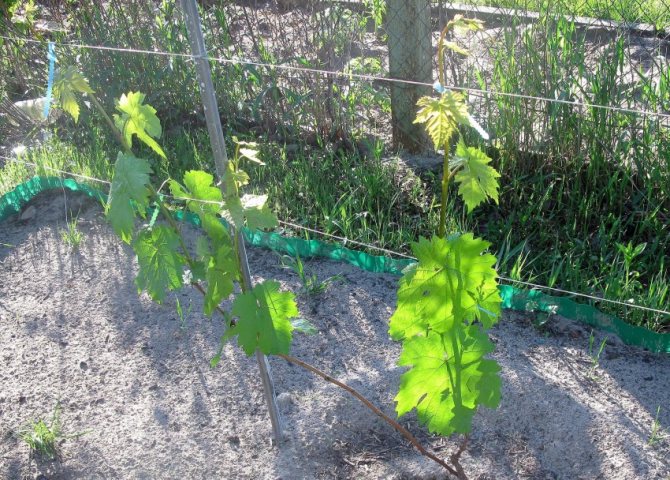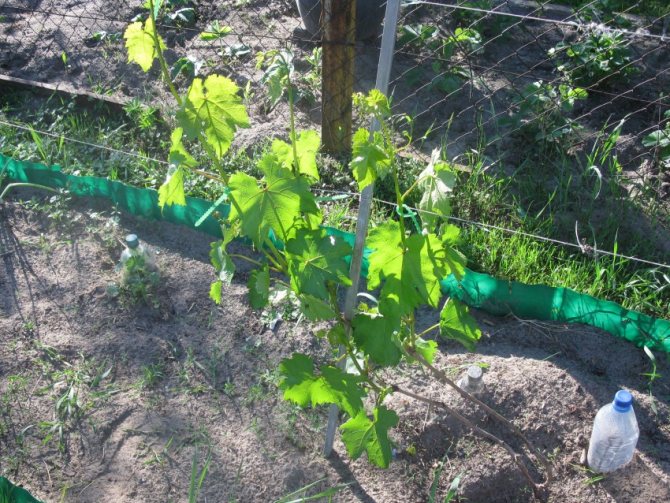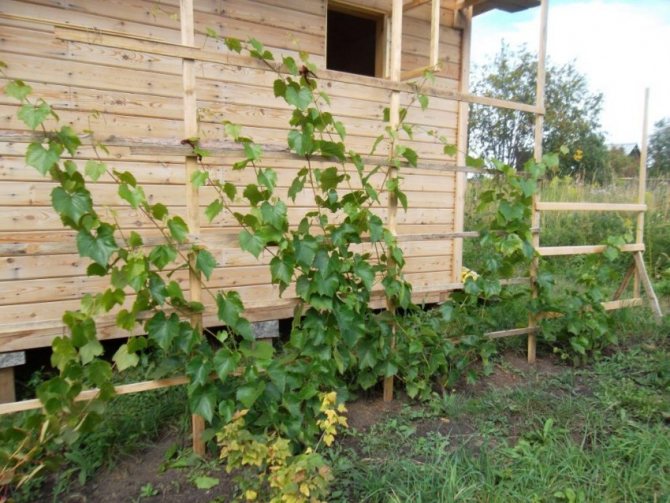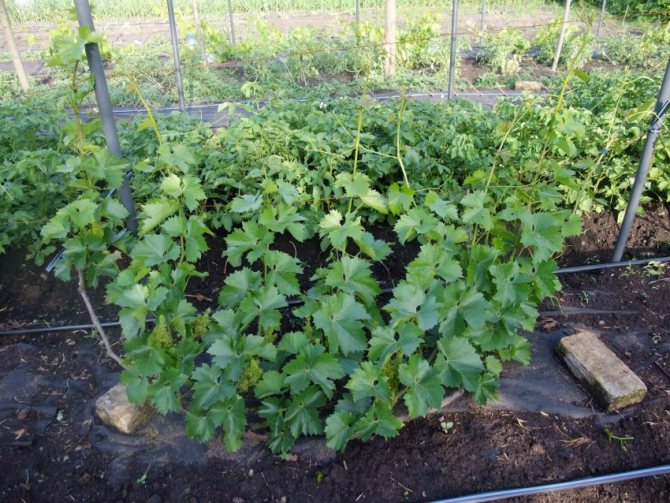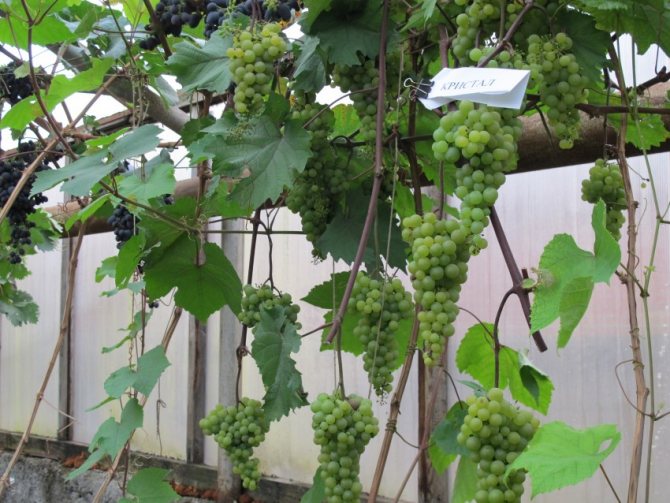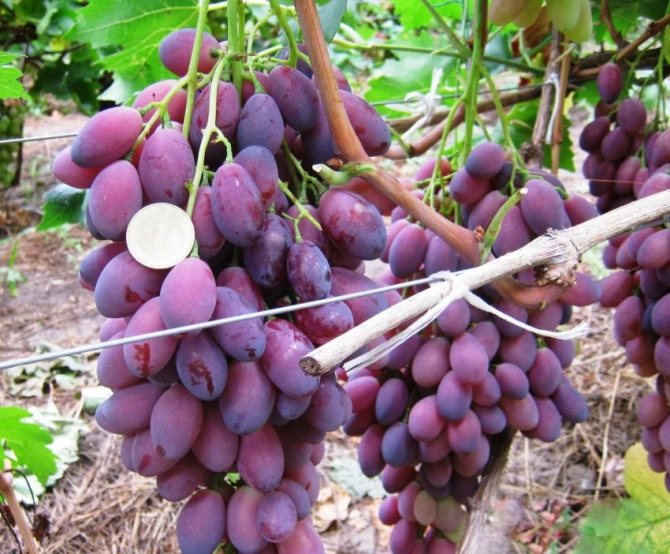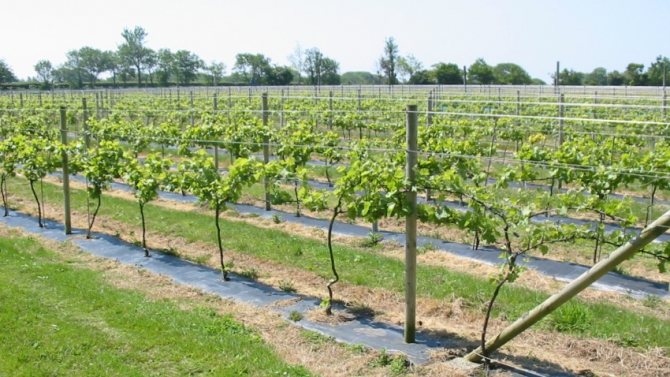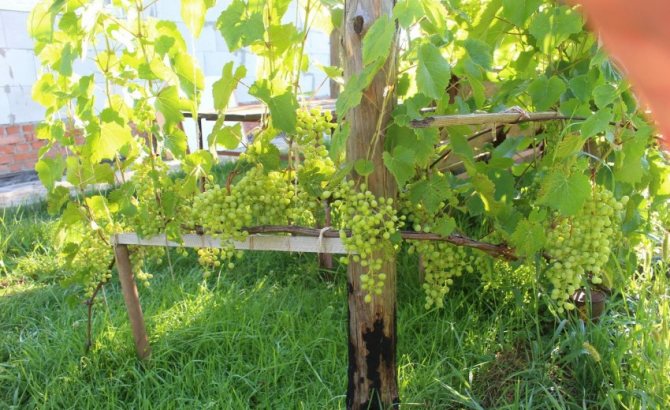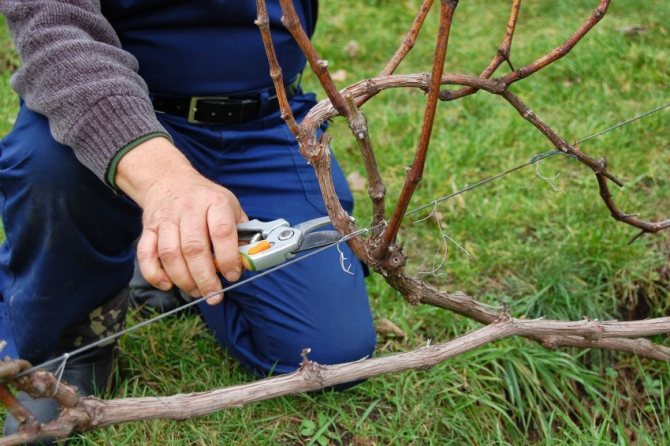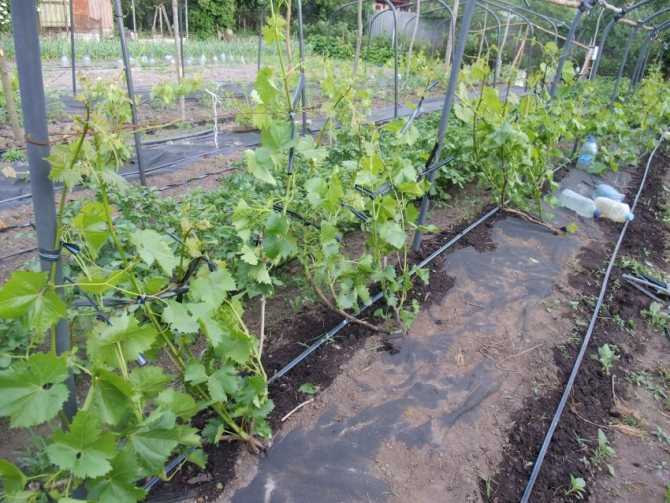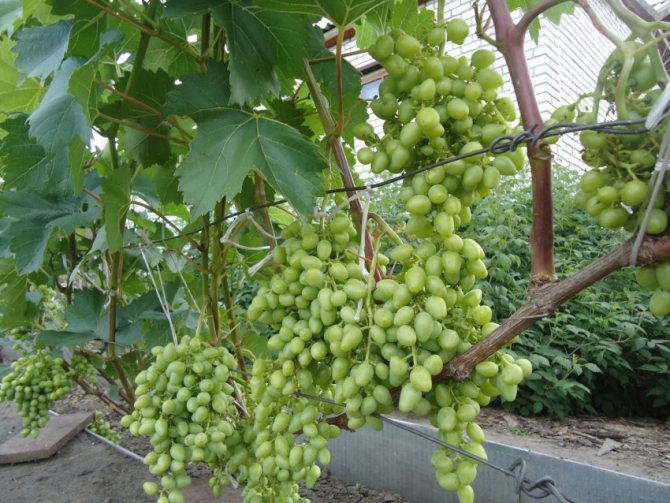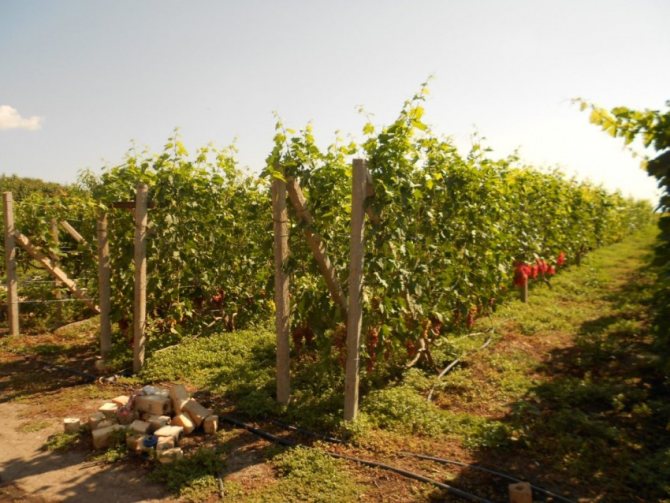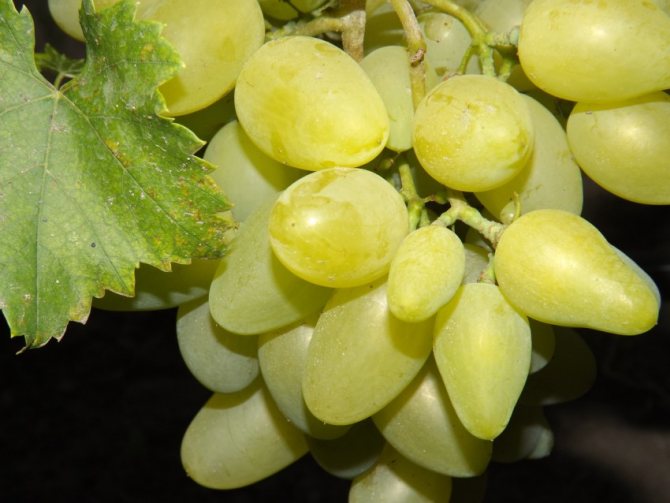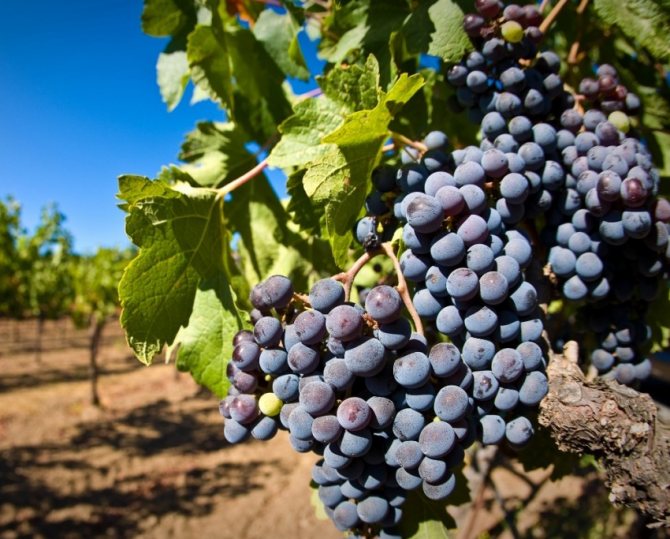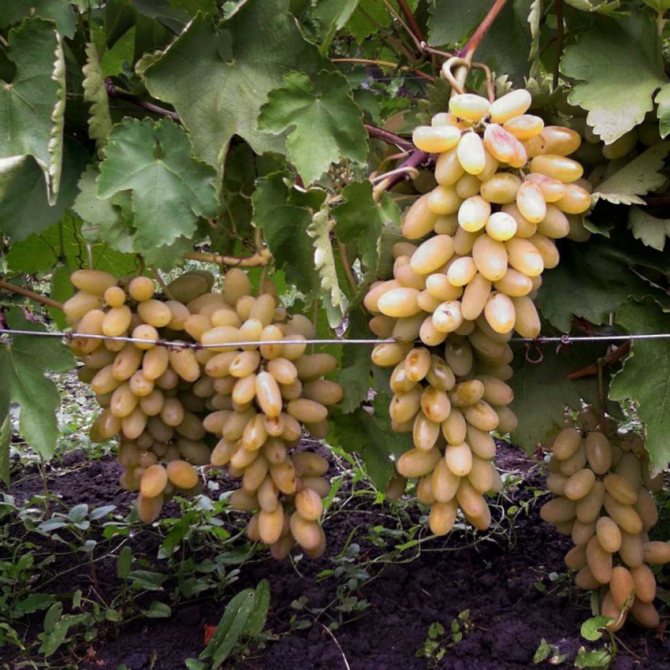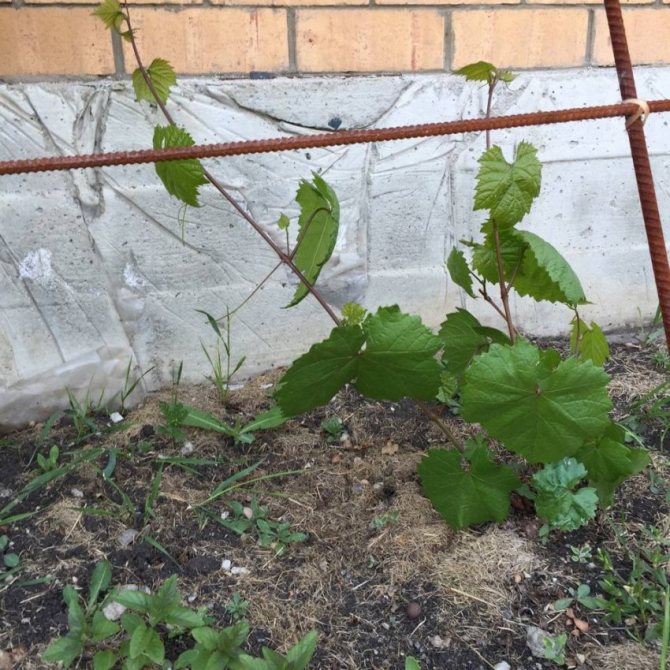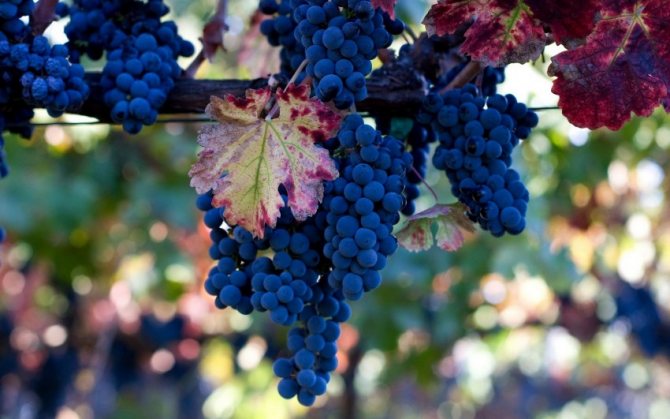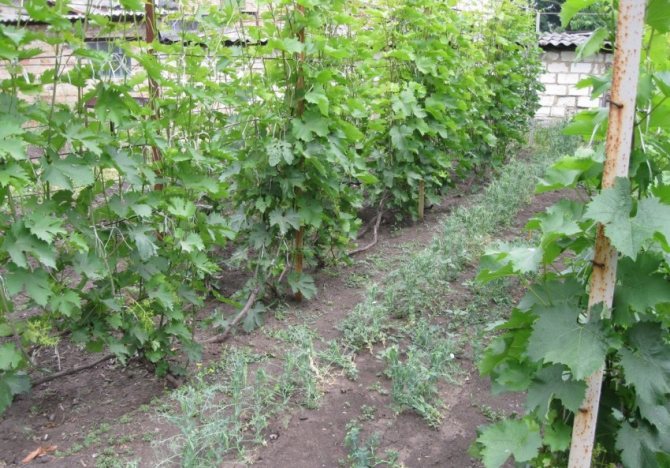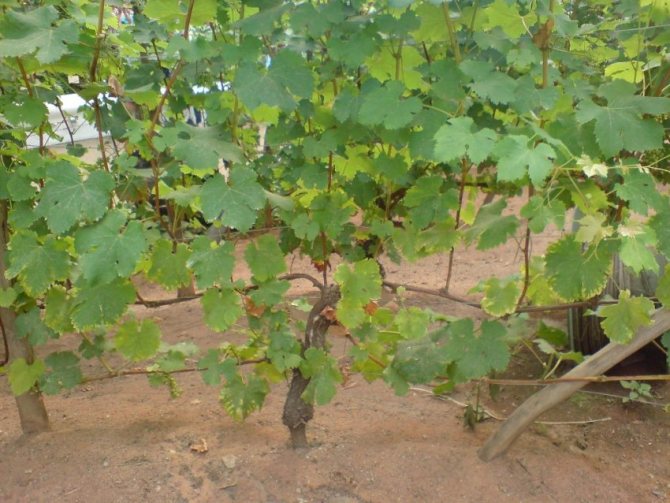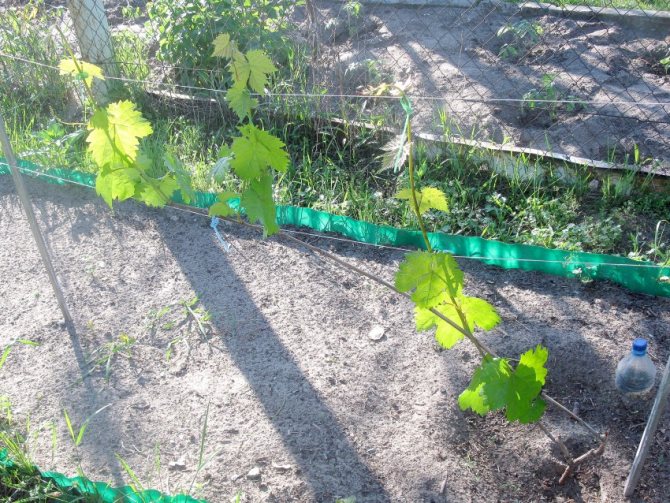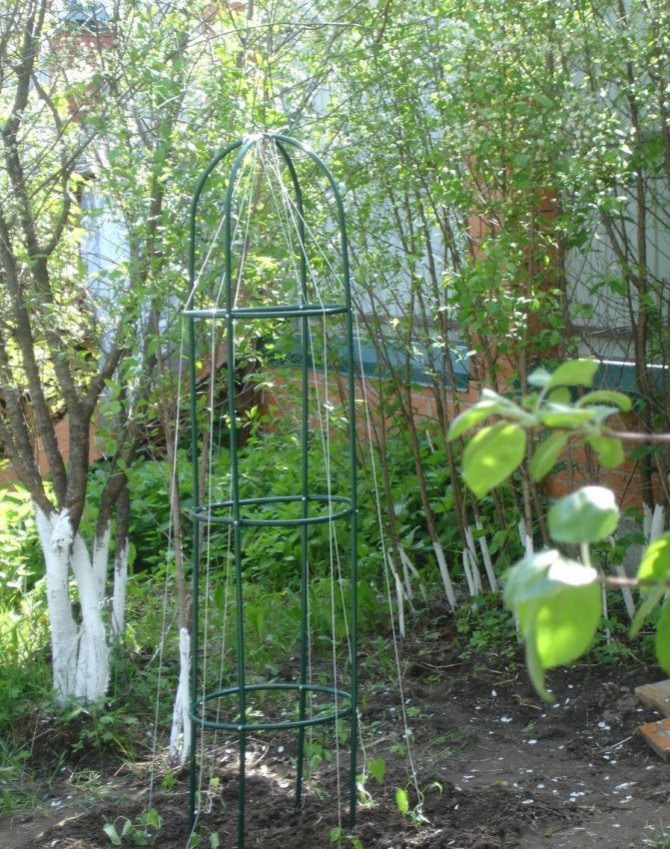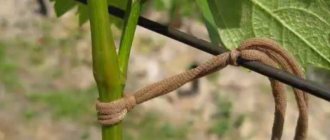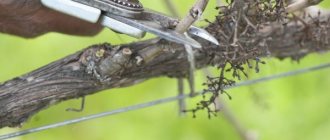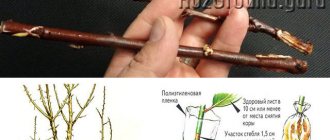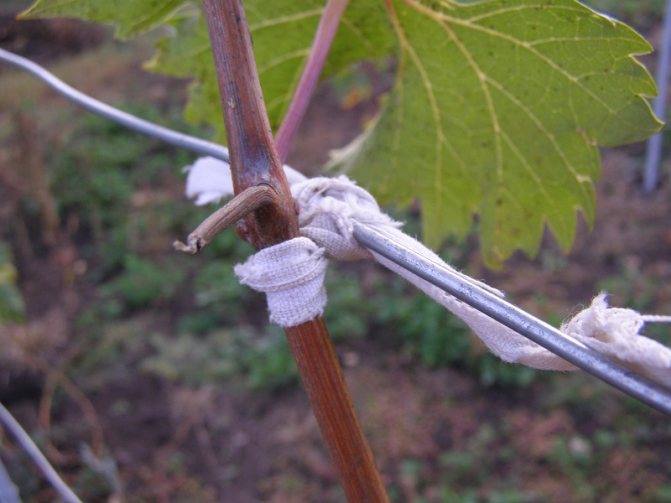
OLYMPUS DIGITAL CAMERA
Grapes are whimsical plants, so to achieve the results of interest, you will have to work hard. Pinching, pinching, pruning - that's not all. The grapes also need to be tied up. In the article we will tell you how to tie the grapes correctly, what materials and schemes are better to use, what difficulties may arise.
The garter of grapes is an integral part of caring for this plant, and, having made a mistake in the garter, you may never wait for the desired harvest, and in general the plant may die
Why tie up grapes and is it necessary?
Many gardeners are wondering if a garter is required or if this event can be skipped when caring for grapes? It is necessary to tie up the grapes, and this must be done correctly. Without this, the plant will hurt: diseases do not take root well where leaves, vines, clusters are well blown by the wind. In addition, the berries get more sun, so they grow larger. In other words, a garter of grapes can be compared with a human skeleton: if it is healthy and strong, the person is strong and mobile, otherwise disease and low immunity are threatened, which is why the growth of the vine cannot be allowed to take its course.
The vine is tied up immediately after the winter insulation is removed. They do this by catching the moment when the frosts have departed, but the buds have not yet begun to bloom - they are very fragile and can break off even from a light touch. The garter during this period is called dry: you have to work with the still dormant vine. Green is called a garter, which is carried out as the vines bloom.
When young branches grow 30-35 cm, they are tied up vertically or at an angle. When the young pagon reaches the next row, it is tied up again. Green tying is carried out several times in the summer. After a strong wind, everything is checked and, where necessary, the stems are additionally tied up. What is important, before starting work, you need to stock up on the necessary material - ropes. It is best to make them out of soft fabric and of sufficient width, then the rope will wrap around the branches widely and not roll into a thin rope.
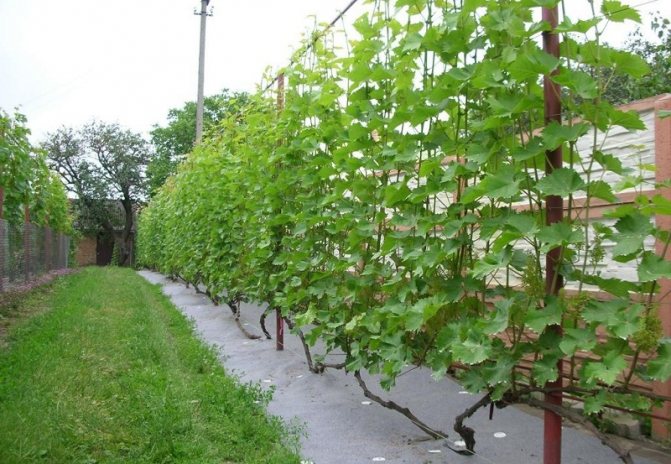

Correct tying of grapes requires certain knowledge and skills, while, if you did not have to tie up grapes before, then it is better to seek help from a specialist or an experienced summer resident
What materials should be chosen for garter grapes
Young bushes do not need to be tied up in the first year. A peg driven into the ground is enough, to which branches are tied. In the second year, it is already necessary to build a support. For its manufacture, it is necessary to prepare concrete or metal supports with a diameter of at least 10-15 cm and a height of over 2 m. You will also need galvanized metal wire. It must be strong enough to support the weight of the bunch of vines. The optimum wire thickness is 1.8-2.4 mm.
It is worth noting that if it is decided to use wood for the manufacture of supports, it is best to use oak, acacia, alder, poplar poles or mulberry poles, as they rot less. A week and a half before installation, the bark is removed from the bottom of the pillars and the cleaned side is immersed in a five percent solution of copper sulfate.After that, the support is dried, and the part of the pillar that is to be dug into the ground is coated with hot resin. This will extend the shelf life of the material, but still the wood will last less than concrete or metal.
Tip # 1. The highest quality and strongest are iron supports, in particular pipes with a diameter of at least 30 mm. If the diameter of the pipes is smaller, then the structure may break in a strong gust of wind.
Thin materials cannot be used as a garter material, as they will quickly damage the bark on the branches. Better to use sida fibers, kenaf, twine, willow shoots, corn wrappers, plastic tapes, cloth scraps. You can also use a well-soaked washcloth. Moreover, it is the sponge that can be called the most convenient, harmless and most suitable for this purpose.
And you can also purchase specially designed plastic clips. These are very durable polypropylene products. The diameter of the rings is 23 mm. Of course, they are suitable for fixing where the thickness of the vines will allow it to be done. The ends of the stems are most suitable for this.
For young grapes, you can use the simplest method - to become a special net for garters of plants, which can be purchased at any specialized store
Garter methods and main steps
The main methods used for tying grape vines are dry and green. When dry, all procedures are performed with lignified and already cut off shoots. They are fixed on the trellis at the lowest tier. If the load turns out to be large, then the tier located above is also involved. They are laid horizontally, and only last year's shoots, intended for the formation of the future trunk, are placed vertically. Old, frozen or damaged branches must be removed.
As soon as the length of the young shoots reaches half a meter, proceed to the green garter. This will help prevent strong gusts of wind from damaging fragile vines and intertwining with each other. Green twigs are fixed exclusively in a vertical position and distributed in such a way that there are no more than 3 of them in one node.
See also
Description of the Super Extra grape variety, features of cultivation and careRead
Otherwise, pollination will be difficult, which will certainly be reflected in the quantitative and qualitative characteristics of the resulting crop. When tying grapes, the material used is initially wrapped around the support wire, and then with its help the vine is fastened. This helps not only to prevent chafing of the branches, but also to protect them from burns provoked by overheating of the wire in hot weather.
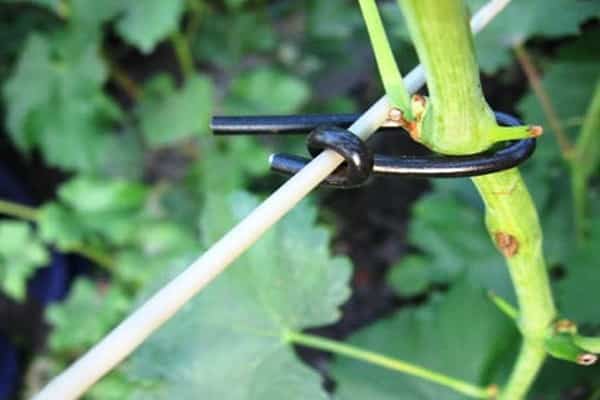

Practical tips for garter grapes
Experienced summer residents and gardeners pay attention to some of the subtleties that affect the result of the entire procedure.
- When tying, it is not advisable to bend the branches too much. It is best to create gentle curves to keep the vine's conductive system working properly. If the branches are bent at an acute angle, power will not flow to those eyes that are located above the fold.
- If possible, you can use a special garter rope, which is made of steel wire wrapped in paper, and special scissors. Their use will greatly speed up the process and facilitate the work.
- In windy weather, the branches can rub against the trellis wire. To prevent this, the garter material must be passed by the "eight", then it will be located between the wire and the stem.
Features of the garter of a young plant
In the first year of life, the grape bush is attached to small wooden pegs. It is allowed to install a small trellis for it, made of a special mesh.Fastening is done with special materials that will not harm the tender young vine.
When installing a coarse mesh as a trellis, it is screwed to supports made of metal or wood. As they grow back, the shoots themselves will trudge vertically upward.


How best to place the vine when tying
To get a high yield, it is very important to do all the work correctly during dry tying. This will make it possible to create equal conditions for the growth of young shoots and blooming points. There are several different types of trellis placement. Each of them is used for plants of different ages. So perennial stems should be placed semi-fan or fan.
Vines with buds are laid in an arc or in a horizontal direction. In this case, the angle of inclination of the vine can be from 45 to 60 degrees. The initial parts of the vine are tied loosely, and the ends are tight. Why is that? Because if the lower branches are fixed tightly, as they grow, the vine will be squeezed in the place of the garter.
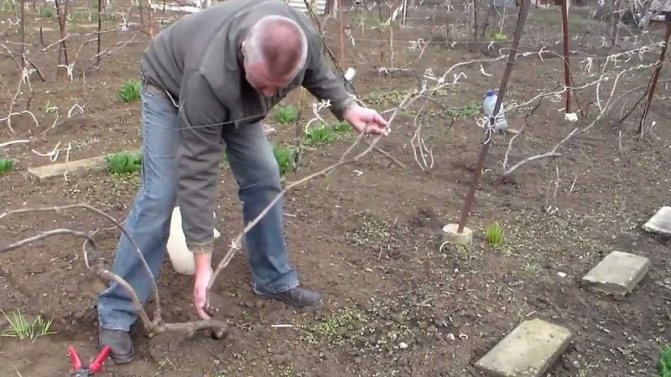

The first thing to do when tying grapes is to install a trellis, which will serve as the main support for the whole plant, it is on the trellis that the branches of the plant and further fasteners are attached
Green garter
The green garter is produced in the warm season, when the shoots are long and reach 30 cm. It is made to protect young stems from bad weather. This method differs in that the shoots are tied up perpendicularly. That is why this method is suitable for bushes with long stems and a high plant location.
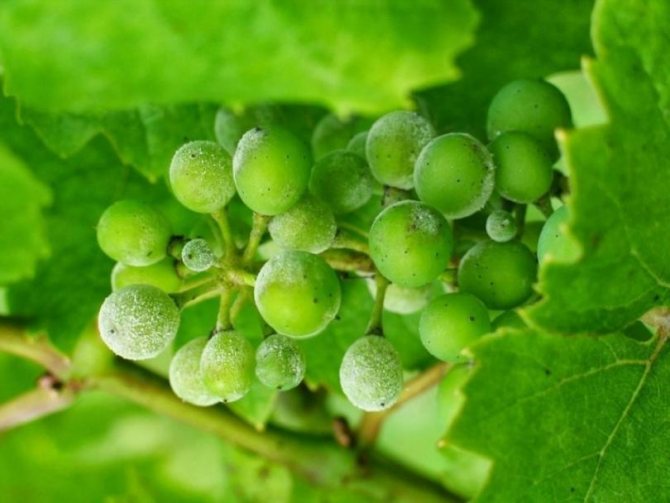

Grape processing - rules and recommendations of experts when and how to spray and fertilize grapes (155 photos + video)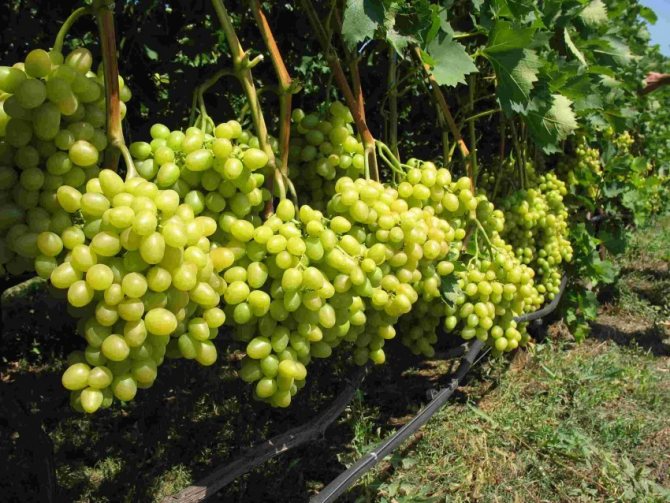

Formation of grapes: simple formation schemes for beginners and expert advice on choosing a method (video instruction + 140 photos)
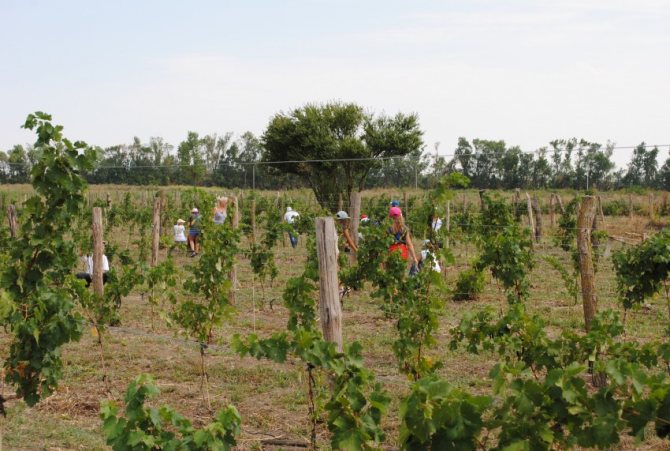

Planting grapes: photo and video tips on how and when is the best time to plant grapes
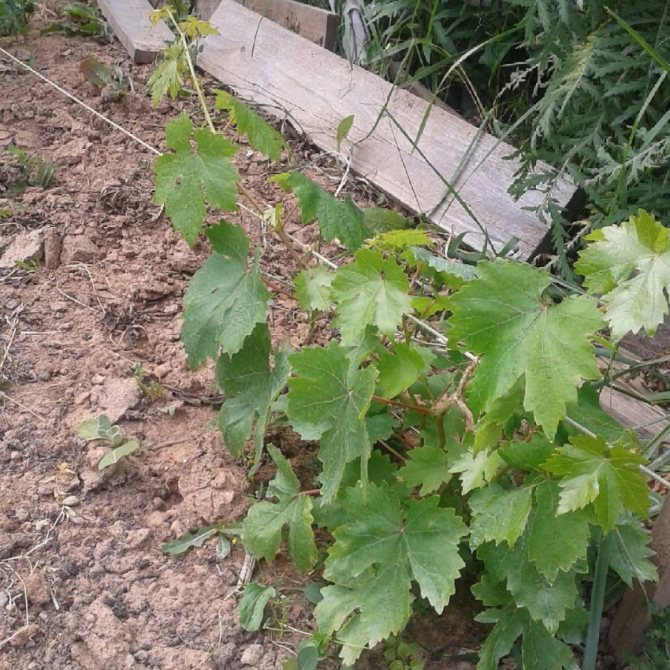

When the shoots become even larger, they are tied up a second time, but already higher. If in the future they have grown even more, but have already managed to form bunches, then the garter should not be done, because you can harm the bush.
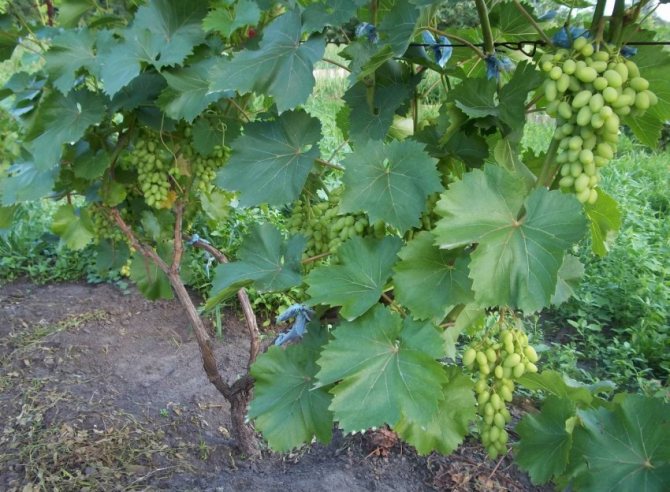

The last time the garter is made is before the grapes bloom, or when the ovaries are already forming. This procedure is done more than 4 times during the whole season.
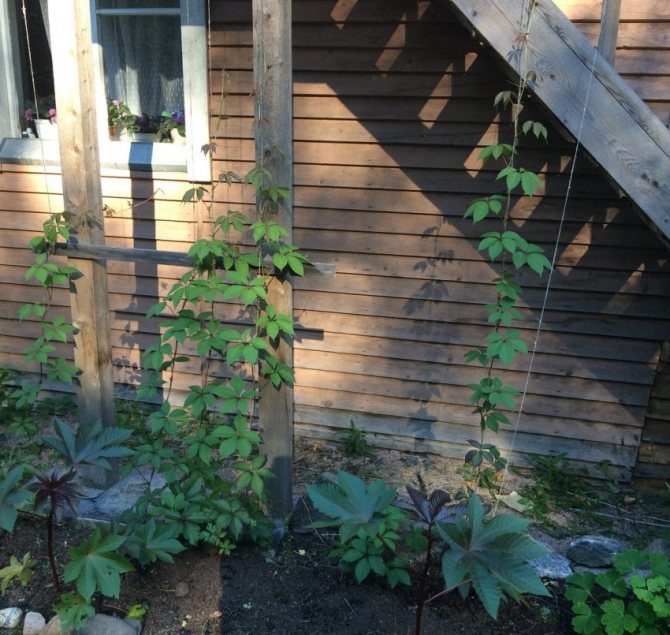

What is a trellis and how to install it correctly
What is a trellis? This is a structure of two pillars dug in at a distance of 3 m from one another and a wire stretched between them. The wire is pulled in several tiers. The first one should be located above the ground at a height of 40 cm. At the same distance from one another, the others are also placed. There can be 4-5 tiers in total, forming a kind of lattice.
First, the stems are cut, those that have been damaged by frost are removed. Further, perennial branches on the first tier. Place them fanwise or half-fannedly. Shoots are fixed on the second tier. They can be placed horizontally, tilted at an angle, but under no circumstances use a vertical garter.
Tip # 2. If you place the stems vertically, the yield of the bush will deteriorate, since due to this situation, only the upper buds on the shoots wake up, and the rest, if they wake up, will be very weak.
The emerging green shoots are tied to the third and fourth tiers of the trellis. Moreover, young shoots are tied up so that they are in a horizontal position or are located in an arc. Thanks to this, even a strong wind will not break them. Very rarely, the stems are tied up in a ring or arc. Because of this, they develop unevenly, which significantly reduces the amount of harvest.
How to tie up?
Let us consider in more detail the methods of garter grapes.
Dry
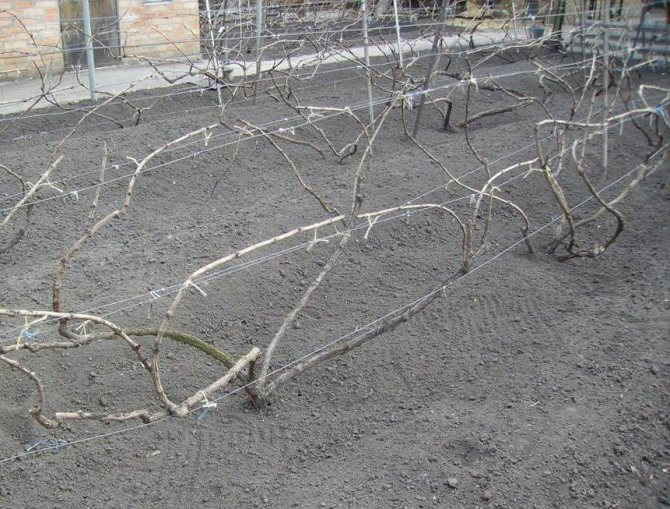

The procedure got its name because in this case, not yet green, old, last year's shoots, which are dormant or at the very beginning of sap flow, are tied up.
As mentioned above, this garter is produced before the grape flower buds open. The sap flow has just begun, but has not yet entered into full force. At a later date, a dry garter is not performed, as there is already a risk of damage during the kidney procedure.
Before the garter, sanitary pruning is carried out, getting rid of the shoots that have frozen over the winter, as well as old, sick and damaged ones. It makes no sense to tie up weak branches, you need to leave only the strong part of the vine.
A dry garter consists of fastening the grapes horizontally at a slight angle. Thanks to this method, the bunches then turn out to be large and juicy, strewn with many berries.
Step-by-step dry garter procedure:
- The shoots are carefully, trying not to damage, bend to the lower crossbar-tier of the trellis.
- Those knots that are near the wire are tied directly to it.
- The branches, on which young green shoots will then form, are tied up later.
After the procedure, it is recommended to feed the grapes with a complex composition with nitrogen, so that the green part of the plant forms more actively. The amount of fertilizer applied is a tablespoon for each bush.
After fertilizing, the soil under the bush is loosened in such a way as to bury the fertilizer to a depth of 10-15 cm.After loosening, a hole 15 cm deep should be formed and left at the base of the vine.This is done so that water accumulates in it during irrigation and rain: it turns out such a kind of water reservoir.
Green


In most regions, the green garter is carried out in the summer, when the shoots have already grown substantially in size. The procedure is aimed at protecting young vines from winds, rains, and other adverse weather events.
In this case, the shoots are attached to the support at a right angle, so a green garter is suitable for those grape varieties that have long whips or differ in a significant stem height.
The green garter is carried out in several stages:
- when the vine grows 30 cm;
- when the whips grow a little more;
- before flowering;
- after the appearance of the ovaries.
It is necessary to carry out at least four such green garters during the growing season. But if the weather is too windy, then after the wind dies down, they make one extraordinary garter.
Attention: after the formation of fruit bunches, garters should no longer be made, as they can damage the future harvest.
The most convenient varieties of trellises
Most often, a single-plane vertical trellis is equipped for a vine garter. This type of structure is considered the best, since the bunches receive the maximum amount of sun, due to which they ripen faster. The bottom row of wire should run at a height of 50-60 cm from the ground. Read also the article: → "Review of the best non-covering grape varieties for gazebos, trellises, for wine."
The advantages of a single-plane trellis include:
- Ease of use.
- The ability to easily and conveniently care for the vine.
- For the construction of the structure, you can use the materials available on the farm.
Disadvantages:
- There is no way to form not one, but several fruit vines.
- The design is not suitable for strong bushes.
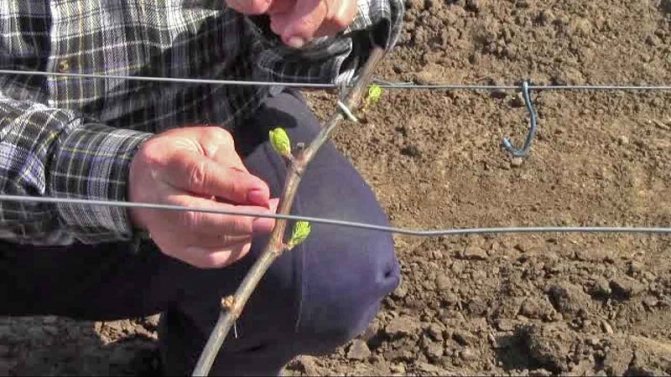

It is worth noting that it is necessary to carry out the garter of grapes several times a year, while in the summer the garter may have to be done 3-4 times, depending on the growth rate of the grapes and its dimensions
Another type of trellis is two-plane. It can be built in two versions. The first option foresees the erection of a structure in two rows on both sides of the bush.In this case, it is necessary to ensure that the distance between the planes is 60 cm or more. The second option is a two-plane inclined structure. In fact, these are two trellises, connected at the base, which then expand at a slight slope. Thanks to the slope of the trellis, sunlight has access to all the leaves.
For the construction of the structure, the same materials are used that are used for a one-plane analogue. Importantly, there is one little trick, thanks to the knowledge of which you can build durable trellises. To do this, you need to use racks of the same height as the row spacing. Of course, with a width between the rows of 3 m or more, you will have to use a ladder for strapping, but the created structure will be strong and stable.
The advantages of two-plane structures include the ability to fold a bush with six or more arms, which allows doubling the number of shoots. The disadvantages can be considered:
- The need to use more materials than for a single-plane trellis.
- Problematic shelter for the vine for the winter. But this point can be solved if you remove the lower wires from the trellis.
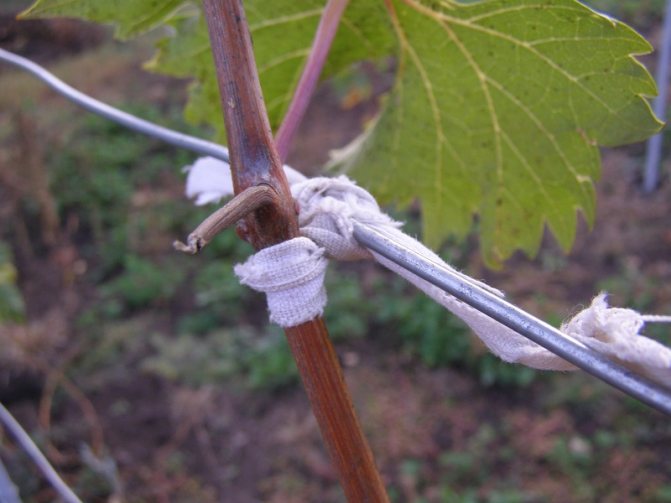

You need to carefully consider the choice of materials for garter grapes, they should not be too hard and thin, so as not to damage the delicate stems, it is better to use a soaked washcloth or even rags
Planting grapes on a trellis. What type of construction is suitable, given the characteristics of the variety?
Most often, growers use two types of trellises:
- Single-plane - vertically located pillars are interconnected by a horizontally stretched wire that holds the vine.
- Two-plane - consist of two one-plane supports, which are installed side by side or interconnected in the form of the letter V.
A simple support is suitable for those gardeners who are not going to grow a lot of grapes. If you are planning a large number of bushes, give preference to a two-plane trellis.
The variety of grapes grown on the trellis is also of great importance, it must be taken into account in accordance with the selected variety. If you choose the wrong support, you may not achieve a good harvest or even lose the vineyard.
Single-plane trellis cannot support a lot of weight, so they are preferable to use for:
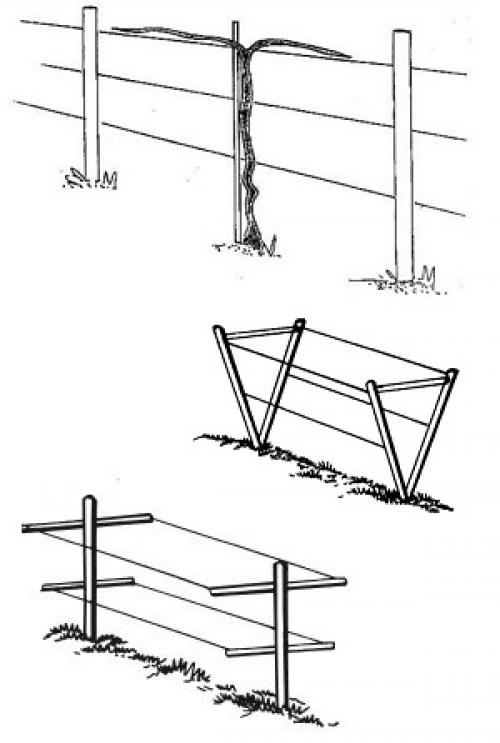

Tapestries for grapes
- Covering grapes.
- A young vineyard.
- Low and medium-sized varieties.
Two-plane trellis, as a rule, are made of metal parts and are suitable for:
- A young vineyard.
- Tall varieties that have many shoots (eg "long-awaited", "veles" or "moldova").
- Non-covering varieties.
The first option is suitable for beginner growers who are not going to grow a lot of vines.
Two-plane trellis can be built according to the drawings on their site by gardeners who have experience in growing grapes, ready to process a large number of vines and collect a large harvest.
Important! When using a two-plane trellis, it must be remembered that in this option it will not be possible to cover the vine for the winter, therefore, non-covering and frost-resistant grape varieties should be chosen.
Common mistakes when tying grapes
- The most common mistake a beginner makes is tying the vine upright.
- Often, fishing line or wire is used as a garter. This is incorrect, as both materials cut the bark on the stem and are therefore unacceptable for the procedure.
- The location of the main vine in one direction is also considered a mistake if there are many stems (four or more). In order for the plant to develop well, you need to divide the branches in half and turn them in different directions.
- Fastening the wire to the pole is a very important point. If it does not hold firmly, the whole structure will stagger in the wind or disintegrate altogether.To prevent this from happening, and the wire was placed under the required tension, they fasten it with lanyards.
Useful Tips
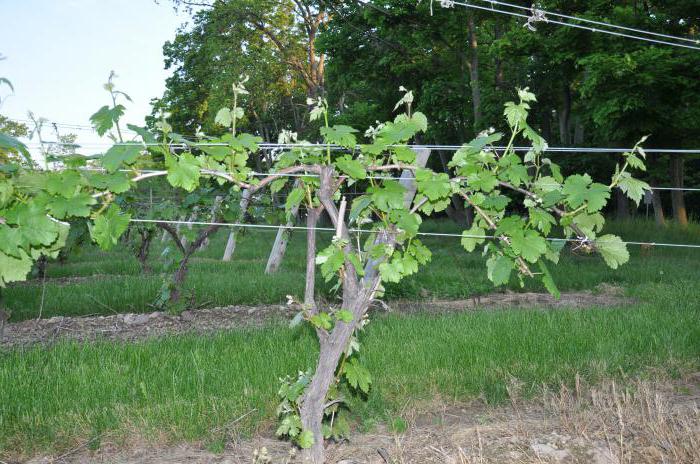

Here are some important tips from experienced winegrowers to help you cope with a responsible procedure.
Do not tie the vine vertically. This is the most common mistake novice gardeners make. The vertical bandage leads to a decrease in yield, fracture of shoots, injury to the vine.
In addition, with a vertical garter, only a few upper buds grow, while the rest are poorly developed. This leads to a significant decrease in yield. It should be tied either horizontally or at a slight angle.
The horizontal arrangement of shoots when tying is an optimal option and has many advantages:
- there is a uniform supply of nutrients to the shoots;
- even, large clusters grow;
- berries are sweet and tasty due to uniform sunlight;
- the plant is protected from fungus due to optimal ventilation and airing.
Perennial shoots on the lower tier are recommended to be placed in a fan or half fan - this way they will be ventilated in the best way.
Shoots should be fixed in such a way as not to squeeze too much, and prevent slipping. The first can lead to a lack of nutrients for the vine, and the second - to plant trauma.
It is wrong to use rigid materials such as metal wire or fishing line for garters. Due to their hardness, these materials can damage the bark of the plant, leading to infection and disease of the grapes. It is recommended to use only soft materials.
You should not place the stems of one vine in one direction when tying. This leads to a thickening of the crown, the lack of normal ventilation - and it is precisely because of the listed points that the procedure is mainly carried out. Shoots must be separated so that they go in different directions - only this approach will ensure their normal ventilation.
It is necessary to fasten the shoots to the support quite firmly. Otherwise, the entire trellis or other structure will be swayed by the wind, it may even fall apart when the grapes become heavy.
Experienced growers advise against tying the vine to the trellis by its upper part. This leads to the fact that internodes located nearby dry out, and the stems begin to grow in different directions. Better to tie at the middle of the shoot or about 2/3 of the length from the base of the vine.
When tying up, try not to bend the shoot too much, you should not form rings, steep arcs from it. This leads to pinching of the shoot - nutrients begin to flow poorly. Such "starvation" of a part of the shoot can lead to the fact that this part will dry out altogether, therefore, the yield will decrease, and the bush itself will be injured. It is necessary to form smooth curves.
In windy weather, the vine often rubs against the trellis bars, which leads to injury. In order to avoid such a negative moment, tie the shoots with a figure eight so that the soft garter material passes between the trellis bar and the stem.
The garter should be done carefully and slowly. Each shoot is taken and attached, tied separately. Only such a thoughtful approach will lead to a successful result and a good harvest.
Popular questions about grape garter
Question number 1. Is it necessary to tie up grapes?
Yes, this process is mandatory and necessary in caring for this fruit plant. Firstly, it affects the growth of the plant itself, and secondly, the number of fruits. If you do not tie up the grapes, then you may never wait for the desired harvest, and sometimes the plants completely die without a garter, as they begin to hurt, are easily affected by pests, and so on.
Question number 2. Can I use fishing line or wire to tie the grapes?
No, you can't, and in no case. This is due to the fact that this material is quite thin and tough, as a result, you can easily damage the delicate twigs of grapes. Therefore, it is better to replace the fishing line and wire with softer and more suitable materials: soaked washcloth, soft ropes, rags. If you use wire, then only thick, in which case it will not harm the plant.
A source
Dry garter
A dry garter is made in early spring, before sap flow. It is necessary to do it on time, while the plant does not develop after winter, otherwise the buds can be damaged, and in the future this will negatively affect the yield.
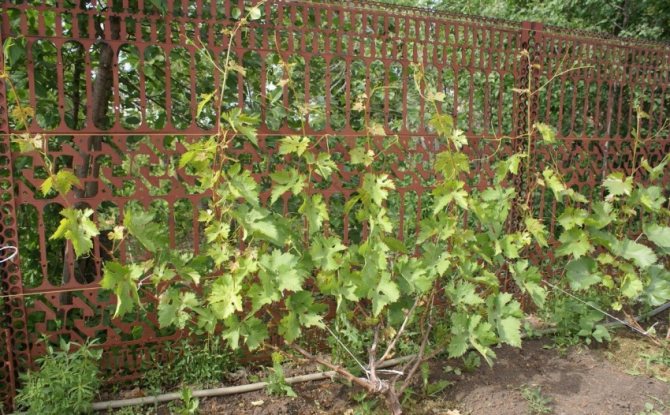

After the first garter is made, you can put 1 tablespoon of fertilizer near the grape trunk, after which it is good to dig up this place. Also, you can make special depressions so that the water passes more easily to the roots of the fruit crop.

